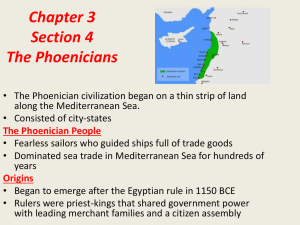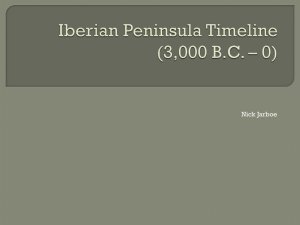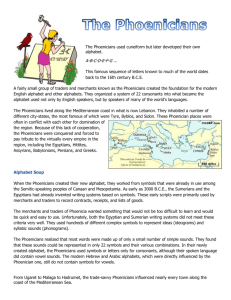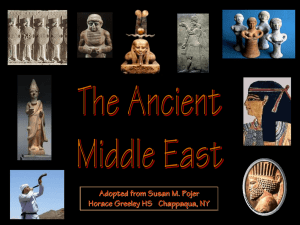Docx
advertisement
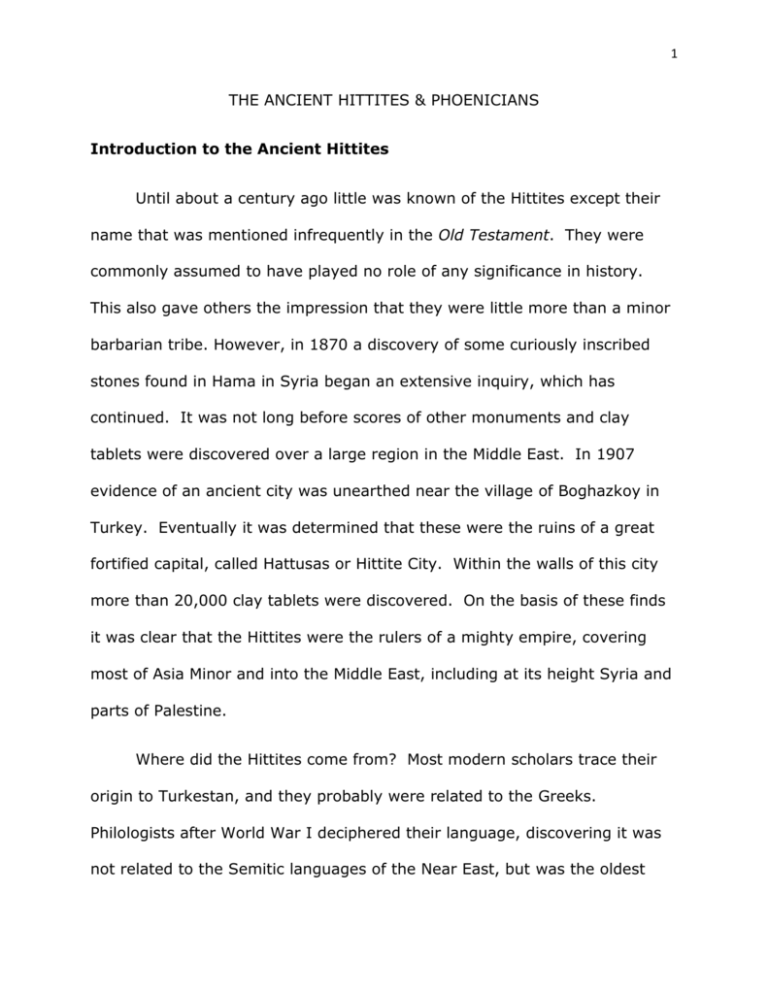
1 THE ANCIENT HITTITES & PHOENICIANS Introduction to the Ancient Hittites Until about a century ago little was known of the Hittites except their name that was mentioned infrequently in the Old Testament. They were commonly assumed to have played no role of any significance in history. This also gave others the impression that they were little more than a minor barbarian tribe. However, in 1870 a discovery of some curiously inscribed stones found in Hama in Syria began an extensive inquiry, which has continued. It was not long before scores of other monuments and clay tablets were discovered over a large region in the Middle East. In 1907 evidence of an ancient city was unearthed near the village of Boghazkoy in Turkey. Eventually it was determined that these were the ruins of a great fortified capital, called Hattusas or Hittite City. Within the walls of this city more than 20,000 clay tablets were discovered. On the basis of these finds it was clear that the Hittites were the rulers of a mighty empire, covering most of Asia Minor and into the Middle East, including at its height Syria and parts of Palestine. Where did the Hittites come from? Most modern scholars trace their origin to Turkestan, and they probably were related to the Greeks. Philologists after World War I deciphered their language, discovering it was not related to the Semitic languages of the Near East, but was the oldest 2 example of what is called the Indo-European script originating from the Sanskrit. This language is the basis of later Greek, Latin and ultimately English. It is surmised that the Hittites reached Anatolia (modern Turkey) by 1800-2000 B.C.E. Over the course of the next three centuries they gradually imposed their rule as warrior elites over the indigenous inhabitants. By 1353 B.C.E. the Hittite Empire was rivaled in size and power only by the Ancient Egyptians. In that year the Hittite King Suppiluliuma received an astonishing message from Egypt’s young Queen Ankhesenamen, the widow of King Tutankhamen, who had recently died before reaching the age of twenty. “My husband has died and I have no sons. They say about you that you have many sons. If you would send me one of your sons, he could become my husband.” The widowed Queen who lacked political support within Egypt probably wanted the security that a Hittite Prince’s army would provide. Such a marriage might have altered the course of history. Suspecting trickery, King Suppiluliuma dispatched an emissary to find out what was really going on. The Emissary was apparently not tactful as the Egyptian Queen replied: “I was insulted at having my motives questioned.” Nevertheless, she renewed and even strengthened her offer. “If King Suppiluliuma would send her a son, then he would be my husband and king in the country of Egypt.” Still the Hittite monarch delayed, dragging out negotiations for almost a year. Satisfied at last the Hittite King sent a son to marry the Egyptian Queen, but it was too late. By then an 3 Egyptian official named Ai had preempted Ankhesenamen’s throne. Upon his arrival in the land of the Nile, the unfortunate Hittite prince was seized and put to death. Political Structure of the Hittities Politically, there were kings or emperors that ruled the Hittites from the capital city of Hattusas. The Hittite king was not only the chief ruler, military leader, and supreme judge but also the earthly deputy of the storm god; upon dying, he himself became a god. Hattusas was located 6000 feet above sea level, and it appears the climate was much better then than now. There was a three and one half mile wall around the city for fortification. Built in the thirteenth century there was a sphinx gate, with a huge rock rampart, quite small compared to the Sphinx in Egypt. There was a secret passageway through to the fortified city that used a corbel arch. They used limestone on the floor to reflect light for those going through this remarkable edifice. For the health and safety of the inhabitants, a clay pipe water supply was constructed with seven reservoirs holding two million gallons of water. The Development of Iron Ore Economically, the ancient Hittites are given credit for developing the mining of iron ore smelting it into wrought iron and eventually making steel. Scholars give them credit for helping to initiate the Iron Age. The iron ore 4 came from their mineral-rich mountains of Anatolia, where forests provided the energy source for the necessary hot fires. While bronze was used for a long time, which was made from copper and tin, it was expensive to produce and not everyone could afford bronze weapons. Iron was not necessarily an improvement over other metals in hardness and sharpness, but it was more plentiful, and thus cheaper. All ranks of warriors could now have iron weapons. The Hittites were known for generations as the finest metal workers of the Ancient Middle East. Agricultural tools were also made and exported by the Hittites, adding to the economic viability of their Mediterranean trading endeavors. By adapting the Sumerian chariot, the Hittites replaced the heavy solid wooden wheels with iron spoked wheels, which was light but strong. These chariots were drawn by horses that were especially bred and trained for combat. The new chariot could charge into battle at high speed, and by using three people in a chariot instead of the traditional two, it became both a defensive and offensive weapon. This Hittite chariot was widely copied by other Near Eastern empires, and chariots dominated warfare for several centuries. About 900 B.C.E. chariots were superseded by cavalry and massed infantry, but in later centuries the ancient Celts did use chariots to fight up to the first century B.C.E., and of course the ancient Romans continued to use them for sporting events in the Circus Maximus. Hittite System of Law 5 One of the most significant achievements of the Hittites was their human system of law. It was more humane than that of the Old Babylonians. Hittites were known as “People of 1000 laws.” Incorporated into their laws were divorce customs and legal limits of rulers, and the drastic punishment of death was used for only eight offenses, including witchcraft, theft of property from the palace, bestiality, and rape. There was an interesting distinction made in defining rape. If you seized and raped a married woman in the mountains, it was a capital crime because her cries for help could not be heard in the villages and towns. If a male attacked a woman in her house, then that woman could be heard if she cried out for help. If she did not, then she would be put to death for adultery as apparently it was the idea that she must have willingly committed adultery. Even premeditated murder was punishable only by a fine. The basic principle of Hittite law was one of restitution instead of retribution. For instance, arsonists were required to replace the property they had burned. Even murderers could go free after remunerating their victim’s heirs, by a payment of silver, slaves, land or a house together with the costs of burial. There is not a single example of such sadistic punishments as flaying, castration and impalement which the Assyrians and others in the ancient Near East seemed to think was necessary for maintaining order. Hittite Social and Economic Customs 6 Other interesting social and economic customs were practiced by the Hittites. Prices were fixed in law for an enormous number of commodities. Not only was the price fixed for luxurious articles, but products of manufacturing, food and clothing. All wages and fees for service were likewise prescribed, with the pay of women fixed at less than half the rate for men. The family structure was based on the patriarchal system with the father having the power of life and death over his children. There is also evidence of the first levirate marriage. “If a man has a wife and a man dies, his brother shall take his wife, then his father shall take her. If also his father dies, his brother shall take his wife [and also] the son of his brother shall [take her]. Hittite Religion Located at Yazilkia is a rock sanctuary and burial site for the Hittite Kings. Carvings of twelve gods on the left and twelve goddesses on the right determine the entrance to this site, indicating the polytheistic practices of these people. Hittites were also known as “People of one thousand gods.” As they were a tolerant polytheistic culture, they also incorporated Hurrian and Syrian deities into their religious pantheon. The Hittites also worshipped the sun goddess, Arinna, who was also known as the mother goddess, and queen of heaven and earth. A golden pendant has been found that worshipers must have worn around their neck, showing Arinna with a sun halo. There was also the weather and storm god Teschub and his wife 7 Hepat. Interesting is the double-headed eagle image as a sign of the royal kingdom, an icon that was used subsequently by many cultures throughout history. Interaction between the Ancient Hittites and the Egyptians In the last years of the Hittite Empire, Egyptians were their major enemies, and there is the famous Battle of Kadesh fought in 1274 B.C.E., where for the first time in written records of battles, the make-up of the two armies with their chariots and battle plans are known. Ramses II was the ruler of Ancient Egypt and King Muwatalli was the ruler of the Hittites. There is not a consensus by scholars as to the outcome of this famous battle. Did the Egyptians win or lose, or was it a draw? Eventually both the Egyptians and the Hittites agreed to refrain from warring against each other, and fight others as allies. It is thought that the first international treaty was struck after this battle, circa 1270 B.C.E. Two years after this agreement was reached the pharaoh Ramses II took a Hittite princess as his bride. Archaeological evidence shows that the fall of the Hittite empire (c. 1193 B.C.E.) was sudden and may have been attributed to large-scale migrations that included the Sea Peoples and to civil wars within the empire. Introduction to The Ancient Phoenicians The Ancient Phoenicians are thought to be the first explorers, sea traders, and colonizers of the Ancient Western World. Originating on the 8 Eastern Shore of the Mediterranean Sea, they later expanded to the rest of the shoreline. Their influence was felt mainly through peaceful trading not military conquest, although later when Rome was expanding down the Italian Peninsula, the Carthaginians (a Phoenician colony from the Eastern Mediterranean Shore) were also attempting to expand beyond their citystate home base of Carthage in North Africa. Political and Economic Aspects Why have the ancient Phoenicians long been ignored by historians? As the English and Greeks were anti-Semitic, they denigrated the Phoenicians whenever possible. Also, in the Old Testament the Phoenicians were considered the evil empire of the ancient world. They were the worshipers of Baal, El, and Astarte, and included infamous people like Jezebel and Delilah according to the Bible. It is thought by scholars today that the original Phoenicians were hill people in Palestine, but migrated to the shores of the Mediterranean Sea, where eventually they set up various city-states and engaged in exporting and importing that led them to becoming like the Japanese and Chinese today. Their system of government was the citystate, and they were governed by a commercial oligarchy. Their greatest city-states were Berytus (present-day Beirut), Byblos, Sidon, and Tyre.1 So attractive were the small wealthy Canaanite kingdoms (Canaanite is another 1 The Greeks would later adopt the name Byblos as the word for book, which later became the English word for Bible 9 word for Phoenicians), that by the sixteenth century B.C.E. the Egyptians controlled them, exacting tribute for four centuries before a series of political convulsions racked the Near East. During this time Egypt was a major trading partner with the Phoenicians. Once the Egyptian yoke was severed, it set these Phoenician city-states free to expand as a maritime mercantile power. While they had their own natural resources in two major areas, timber from the Cedars of Lebanon, and purple dye from the sea mollusks from the sea, they were also engaging in manufacturing and trading of items from other natural resources like ivory, glass, copper, tin, iron, gold, and silver. Profit margins were huge. The Greeks imported terra cotta masks, and Olympic medals made by the Phoenician artisans. In Homer’s Ililad Phoenician silver bowls that were offered as prizes for runners at funeral games drew lavish praise: “For its loveliness it surpassed all others on earth.” Ancient sources attest that the Phoenician city-states even had the technology to get fresh water from wells dug deep into the Mediterranean Sea basin. Strabo, the Greek historian, remarked that Aradus, a hundred miles to the north of Tyre, tapped springs at the bottom of the Sea between the mainland and their island, which were covered in lead housing to keep out the salt water. They even engaged in massive building projects of new harbors, six storey high buildings, and were hired as contractors to build Solomon’s Temple in Jerusalem. In the Bible, the prophet Isaiah described the leading city-state Tyre of the Phoenicians as “the crowning city, whose 10 merchants are princes, whose merchants are the honorable of the earth.” The Phoenicians’ most famous trade products were textiles that they bought from Egypt and purple dye. With cotton, flax and wool cloth they created elaborate garments, in vivid contrast to the plain garments of the ancient Egyptians and Greeks. By boiling sea mollusks the Phoenicians were able to make soft pink to deep purple, which because of its expense became known as royal purple, and it was reserved for monarchs and high-ranking individuals.2 At different times the dye was worth at least ten times its weight in gold. Both the words Phoenician and Canaan in the Greek and Semitic languages probably means purple. By cutting down the Cedars of Lebanon, and cypress and pine trees, timber was another natural resource the Phoenicians traded, mostly with Egypt to build the hundreds of boats that plied the Nile and beyond. Oil from the fragrant cedars was also used by the ancient Egyptians for soaking linen cloth that bound the mummified bodies of their dead. Phoenicians’ invention of the first true alphabet To simplify all these lucrative trading transactions, the Phoenicians invented the true alphabet around 1000 B.C.E. By that time written languages had evolved from pictographic systems, to having each symbol represent spoken sound. By using crosses, circles, and slanting lines, the Phoenicians 2 Actually scholars now give credit to the ancient Minoans for using sea mollusks to obtain purple dye before the Phoenicians. 11 simplified the alphabet, which was ideal for busy accountants making notations on papyrus. Twenty-two signs of the Phoenician alphabet stood for both vowels and consonants. Greeks perfected the Phoenician alphabet that was then modified slightly by the ancient Romans, which we use today.3 This new alphabet gave the Phoenician merchants a definite advantage over their competitors. Religious Practices Phoenician religious practices are encumbered by lack of detailed information even though there are 6000 extant primary sources. According to the scholar, Richard J. Clifford, these original sources do little more than mention deities, clients, and rituals, and there is no deity list. Lambasted by the Hebrews in the Bible, historians also need to be leery of the work of the Hellenistic Philos of Byblos when reconstructing the Phoenicians’ religion. Although names of the deities in the Pantheon varied from city-state to citystate, a triad of deities prevailed. Their principal god was El or Baal, and the mother goddess was Astarte or Asherah. The young god Adonis was often Astarte’s son, whose yearly death and resurrection reflected the annual cycle of the seasons. It appears that the mother goddess Astarte was the premier deity worshiped by the Phoenicians. Great temples were built by the Phoenicians to honor these three deities, and pigs were the animal usually 3 They are detailed charts that show this transformation. 12 sacrificed. Later on in the city-state of Carthage, it is thought that young children were sacrificed, but this will be discussed under the Punic Wars in the Roman History section. Colonization of the Phoenicians – specifically the Carthaginians Gradually the Phoenicians grew more adventurous as they travelled and traded to the islands of Malta, Sicily, and Sardinia. Phoenicians claimed that they were the first to undertake regular trips beyond the sight of land, and to travel at night, steering by the stars. They founded settlements just about everywhere they went: Cyprus, North African Coast, Spain, Sicily, Sardinia, and Corsica. Then their next step was navigating through the Straits of Gibraltar, 2500 miles from their home ports on the Lebanese Coast, trading with the people on the Moroccan Coast.4 How were the ancient Phoenicians able to communicate and trade with other peoples who did not speak the Phoenician language? According to the Greek Historian Herodotus, their trading tended to follow certain rituals. Phoenicians would spread their wares on the beach, then return to their ships, and start a smoky fire to signal their presence. Local people would then go down to the beach, inspect the goods, and put down what they felt was an appropriate amount of gold, and then withdraw. Then the Phoenicians would return, and collect the gold if they deemed it was adequate. If it was not then they 4 In the book America B.C., it even relates the Phoenicians’ travels to New England and up the Mississippi River to copper resources. It is even postulated that the Phoenicians may have circumnavigated the African continent. 13 would go back to their ships while the buyers added to the payment pile. Surprised at the efficacy and fairness of this silent bargaining, Herodotus wrote: “Neither side cheats the other because the sellers did not touch the gold until it seemed to them to have reached the value of the goods, and the others did not touch the goods until the Phoenicians had taken up their money.” Conflict between Carthage and the Romans Carthage, located today in the country of Tunisia, was the most important of the new colonies that the Phoenicians founded. According to the Greeks, its foundation in 813 B.C.E. was done by Elissa, sister of King Pygmalion, who fled with her followers when the King plotted to murder her husband. 5 Over the next centuries the Phoenician homeland on the Eastern Mediterranean seaboard was conquered by the Assyrians and Greek expansion in the Western Mediterranean threatened the rest of Phoenician trade, but Carthage managed to maintain power until it was conquered by the Romans after three famous wars from the 3rd century B.C.E. to the 2nd century B.C.E., called the Punic Wars (Punic is Latin for Phoenician). In the end Carthage was destroyed in the final war, even though under their famous General Hannibal they won the important battle at Cannae in the Second Punic War. 5 There is another interesting tale that relates how she outfoxed the indigenous people when purchasing land.



